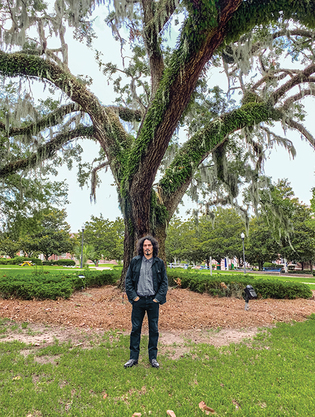
Marie Vickles, 2020
Peruvian American artist William Cordova ’04MFA spoke with Lee Anna Jackson, research editor for this magazine. The interview has been condensed and edited for clarity.
View full image
William Cordova ’04MFA has been known to turn old shoes, tires, aged books, vinyl records, and other found objects into the type of thought-provoking artwork meant to leave one pondering over objects and perceptions that change over time. His 2006 installation, The House that Frank Lloyd Wright Built 4 Fred Hampton y Mark Clark, used wood framing, vintage photos, and a copy of Thoreau’s Civil Disobedience to recall the 1969 police murder of two Black Panthers. Currently a Guggenheim Fellow, Cordova has participated in solo museum exhibitions around the globe. After five years of experience as an organizer for the Prizm African Diaspora Art Fair in Miami, he also curates; most recently, he cocurated the Greenwood Art Project, which commemorates the 100th anniversary of the Tulsa Race Massacre. He will be exhibiting some of his own work at Columbia University in New York City this November.
Lee Anna Jackson: You were born in Peru and then moved to Miami when you were still young. Did you always want to be an artist?
William Cordova: I was interested at one point in being an astronaut. I don’t think I ever made up my mind and said, “I want to be an artist.” It was more a survival tool for me. Growing up, we had what we needed and that was it. My mom would give us butcher paper and we would draw and make landscapes with cardboard and drawn-out figures. We didn’t know that we didn’t have money for toys. She gave us the space to express without limitations, without boundaries.
LAJ: Are your siblings also artists?
WC: My sisters and brothers could all draw really well. The difference between them and myself is they didn’t have the passion. My mom [encouraged] me to pursue my passion and ignore my father’s wishes for me to drop out of college and “become a real man” and get a job.
LAJ: You’ve had the opportunity to focus on your talent through residencies with the Studio Museum in Harlem and the American Academy in Berlin, Germany, among others. How would you describe your art now?
WC: I would describe it, if I have to, as alchemy.
LAJ: How would you describe it to a blind man?
WC: Or a blind woman. I wouldn’t describe it. I would let them touch it. It’s very textural.
LAJ: How do you decide what materials to use?
WC: The materials I use are usually based on research that I’m doing. It’s shaped and culled from what I have accessible at that point in time, meaning you’re not going to find me in an art supply store. I’m most likely going to pick up debris or dirt from a historical location that I’m working from and transform that into ink or paint. It’s more ethnographic.
LAJ: Your sculptures, installations, and paintings all make such strong statements. What is the message behind your more colorful pieces?
WC: You’re referring to the paint-chip color pieces. It’s a series of works based on textile and coding. Every culture does that. They encode the culture into abstractions and textile work, or mosaics, or in fabric. So, all of those paint chip pieces are actually different Andean martial art movements I learned as a child in Peru. They are just abstracted.
LAJ: After graduating from the School of the Art Institute of Chicago, why did you decide to come to Yale?
WC: The artists that I was around were much older than I and already in their careers, but there wasn’t a lot of rigorous thinking to their work. I was very uncomfortable about being comfortable, about settling, about creating work automatically, as if it’s just a product. One of my friends, Michael Richards, said, “You really have to go to grad school because you seem to have taken your practice as far as it can go. You need some more critical exchange with your peers and you’re not going to get that where you are now.” I visited Yale and realized that people I admired, like filmmaker D. A. Pennebaker [’47E] and art historian
Kellie Jones [’99PhD] were teaching at the school.
LAJ: What do you remember most about Yale?
WC: Yale for me was a space/place that challenged, confused, and shaped me.
 loading
loading